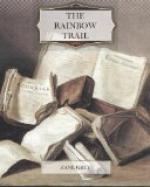“Then came the missionaries. They were proselytizers for converts to their religion. The missionaries are good men. There may be a bad missionary, like Willetts, the same as there are bad men in other callings, or bad Indians. They say Shadd is a half-breed. But the Piutes can tell you he is a full-blood, and he, like me, was sent to a white man’s school. In the beginning the missionaries did well for the Indian. They taught him cleaner ways of living, better farming, useful work with tools—many good things. But the wrong to the Indian was the undermining of his faith. It was not humanity that sent the missionary to the Indian. Humanity would have helped the Indian in his ignorance of sickness and work, and left him his god. For to trouble the Indian about his god worked at the roots of his nature.
“The beauty of the Indian’s life is in his love of the open, of all that is nature, of silence, freedom, wildness. It is a beauty of mind and soul. The Indian would have been content to watch and feel. To a white man he might be dirty and lazy—content to dream life away without trouble or what the white man calls evolution. The Indian might seem cruel because he leaves his old father out in the desert to die. But the old man wants to die that way, alone with his spirits and the sunset. And the white man’s medicine keeps his old father alive days and days after he ought to be dead. Which is more cruel? The Navajos used to fight with other tribes, and then they were stronger men than they are to-day.
“But leaving religion, greed, and war out of the question, contact with the white man would alone have ruined the Indian. The Indian and the white man cannot mix. The Indian brave learns the habits of the white man, acquires his diseases, and has not the mind or body to withstand them. The Indian girl learns to love the white man—and that is death of her Indian soul, if not of life.
“So the red man is passing. Tribes once powerful have died in the life of Nas Ta Bega. The curse of the white man is already heavy upon my race in the south. Here in the north, in the wildest corner of the desert, chased here by the great soldier, Carson, the Navajo has made his last stand.
“Bi Nai, you have seen the shadow in the hogan of Hosteen Doetin. Glen Naspa has gone to her grave, and no sisters, no children, will make paths to the place of her sleep. Nas Ta Bega will never have a wife— a child. He sees the end. It is the sunset of the Navajo. . . . Bi Nai, the Navajo is dying—dying—dying!”
XV. WILD JUSTICE
A crescent moon hung above the lofty peak over the valley and a train of white stars ran along the bold rim of the western wall. A few young frogs peeped plaintively. The night was cool, yet had a touch of balmy spring, and a sweeter fragrance, as if the cedars and pinyons had freshened in the warm sun of that day.




